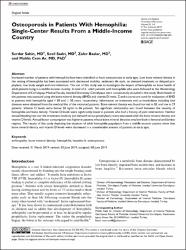| dc.rights.license | https://www.creativecommons.org/licenses/by-nc/4.0/ | * |
| dc.contributor.author | Şahin, Serdar | |
| dc.contributor.author | Sadri, Sevil | |
| dc.contributor.author | Başlar, Zafer | |
| dc.contributor.author | Ar, Cem Muhlis | |
| dc.date.accessioned | 2019-12-20T06:43:33Z | |
| dc.date.available | 2019-12-20T06:43:33Z | |
| dc.date.issued | 2019 | en_US |
| dc.identifier.citation | Şahin, S., Sadri, S., Başlar, Z. ve Ar, C. M. (2019). Osteoporosis in patients with hemophilia: Single-center results from a middle-income country. Clinical and Applied Thrombosis/Hemostasis, 25. http://dx.doi.org/10.1177/1076029619861689 | en_US |
| dc.identifier.issn | 1076-0296 | |
| dc.identifier.issn | 1938-2723 | |
| dc.identifier.uri | http://dx.doi.org/10.1177/1076029619861689 | |
| dc.identifier.uri | https://hdl.handle.net/20.500.12511/4573 | |
| dc.description.abstract | Increased number of patients with hemophilia have been identified to have osteoporosis at early ages. Low bone mineral density in the setting of hemophilia has been associated with decreased mobility, sedentary life style, on demand treatment or delayed prophylaxis, low body weight and viral infections. The aim of this study was to investigate the impact of hemophilia on bone health of adult patients living in a middle income country. A total of 61 adult patients with hemophilia who were followed at the Hematology Department of Cerrahpaşa Medical Faculty, Istanbul University-Cerrahpaşa were consecutively included in this study. Bone health of the patients was assessed using the bone mineral density (BMD) and vitamin D levels. Z and t scores are used for evaluation of BMD in patients with hemophilia aged < 50 and ≥ 50 years, respectively. Information on treatment and co-morbidities including viral diseases were obtained from the medical files of the recruited patients. Bone mineral density was found normal in 30, and low in 29 patients. Vitamin D levels were below 20 ng/ml in 46 patients. No significant relationship was found between the severity of hemophilia and bone density. Vitamin D levels were significantly lower in patients who had a history of joint intervention. Neither annual bleeding rate nor the treatment modality (on demand versus prophylaxis) were associated with the bone mineral density and vitamin D levels. Annual factor consumption was higher in patients whose bone mineral densities was low both in femoral and lumbar regions. The results of this study depicting the situation of adult hemophilia population from a middle income country show that bone mineral density and vitamin D levels were decreased in a considerable amount of patients at early ages. | en_US |
| dc.language.iso | eng | en_US |
| dc.publisher | SAGE Publications Inc. | en_US |
| dc.rights | info:eu-repo/semantics/openAccess | en_US |
| dc.rights | Attribution-NonCommercial 4.0 International | * |
| dc.subject | Arthropathy | en_US |
| dc.subject | Bone Mineral Density | en_US |
| dc.subject | Hemophilia | en_US |
| dc.subject | Hepatitis B | en_US |
| dc.subject | Osteoporosis | en_US |
| dc.title | Osteoporosis in patients with hemophilia: Single-center results from a middle-income country | en_US |
| dc.type | article | en_US |
| dc.relation.ispartof | Clinical and Applied Thrombosis/Hemostasis | en_US |
| dc.department | İstanbul Medipol Üniversitesi, Tıp Fakültesi, Dahili Tıp Bilimleri Bölümü, İç Hastalıkları Ana Bilim Dalı | en_US |
| dc.identifier.volume | 25 | en_US |
| dc.relation.publicationcategory | Makale - Uluslararası Hakemli Dergi - Kurum Öğretim Elemanı | en_US |
| dc.identifier.doi | 10.1177/1076029619861689 | en_US |
| dc.identifier.wosquality | Q3 | en_US |
| dc.identifier.scopusquality | Q2 | en_US |


















